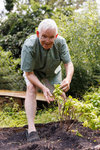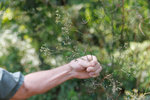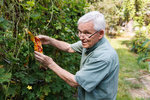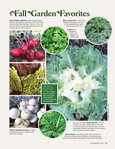



I am about to rip out most of my tomatoes, okra, squash, peppers and other declining summer vegetable plants.
Why?
I can grow 10 times the food in the same space if I plant fall crops now.
We can plant so many tasty crops that will do well that I can’t mention them all here. Even better, most fall crops are leafy vegetables. You eat almost the whole plant because the leaves and roots on most fall crops can both be eaten, including turnips and carrots.
One of the earliest crops you can grow, by the way, are Japanese turnips. Some look like white eggs when harvested at 40 days. Radishes are ready to pick in 45 days. That means you get a fast harvest with some root and leaf crops and a prolonged harvest with others. Consider carrots, which you can start harvesting in two months.
The time to get started on fall gardening is now.
The many advantages to planting fall vegetables include:
The harvest season lasts longer on heat-sensitive plants.
Weeds are easier to control.
Working conditions, with the onset of cool weather, are much better than in summer.
Many crops can be wintered over for continuing harvest in spring.
Leaf crops will be more tender, sweeter and tastier when harvested in the cool of autumn through spring than when picked in summer.
The same goes for root crops, such as turnips, beets, carrots and parsnips. Sweet peas will be sweeter, too.
For starters, broccoli should be set out now. It can be sown, or plants can be purchased and set out.
Lettuces can be sown now, and harvest can begin by Oct. 20 on leaf lettuces. Light frosts won’t kill the lettuce, so harvesting can continue into November or later, depending on when and if we get really hard freezes.
There are many fine varieties of lettuce. Try several; romaine, ruby, Simpson, buttercrunch, and iceberg all will succeed in the fall. Also sow collards and kale now, or choose kohlrabi, mustard greens, Chinese cabbage, radishes, turnips and others. Kohlrabi, radishes and some turnips mature quickly.
Spinach is best sown in cooler weather. Do not pick it all. Let some continue to grow through winter, and you can harvest an especially good crop in spring. The Bloomsdale variety is hardy and almost always survives our mild winters.
Sow carrots now, and sow more than you’ll pick this fall. After carrots begin to form, cover the extras with pine straw about 3 inches thick. In winter through spring, pull back the straw and harvest a few fresh, tasty carrots.
It’s a good idea to add lime and humus to your soil before tilling in the weeds. Then add fertilizer and till again. Wait a week for some rain and for the soil to mellow, and you’ll be ready to plant.
Most leaf crops do best with high fertility. Small fertilizer applications every three weeks are a good idea. A nitrogen-rich fertilizer, such as organic fertilizers high in blood meal, are ideal for leafy greens. Root crops prefer less nitrogen. A high percentage of cottonseed meal and phosphates will help produce strong root growth in carrots, turnips, beets and kohlrabi.
Several home gardeners have asked me how to keep kohlrabi roots from pushing up out of the ground. The fat, thickened roots, actually thickened stems, naturally grow above ground. Don’t try to bury them.
Here is a roundup of great vegetables to grow now:
Broccoli: It’s late for seeds, but they will still work. Starting with plants will work better. Probably the healthiest of the cole crops, it matures quickly and steams beautifully. Harvesting is an art. Never wait until the flower buds open.
Cabbage: Plants will be available at planting time at garden centers and plant sales.
Swiss chard: Start seeds in good potting mix in foam cups. Put four seeds in each cup. Chard can be notoriously slow to sprout. When the plants have four true leaves, set them out in the garden. Chard will grow all season in a mild winter. It usually regrows after cold kills it back. Plants are often offered for sale in garden centers and plant sales by Fayetteville Technical Community College’s horticulture department.
Carrots: Start now or in late February or March. Begin harvesting in late November. Mulch well and harvest through winter. Start another crop in late winter through May. Mulch well to keep the soil cool and moist and harvest into July.
Red-veined sorrel: Also called bloody dock, this is a beautiful perennial that can be harvested and eaten when young and tender. It makes salads beautiful. I consider it a good ground cover. Keep it well watered and you will have it for the rest of your life. This is quite acidic and is used in place of vinegar in French salads.
Endive: Another tart and slightly bitter part of your salad. Also plant Simpson, romaine and other similar loose-leaf lettuces. I like spicy mustards in salads, too.
Kale, cabbage, collards and other cole crops: Kale has wonderful flavor and tastes better to me than collards, and it bears all winter and spring. I am especially fond of bok-choi, Chinese cabbage and other Asian cole crops. Plant now and in March for harvest all spring and summer. There are many colors, shapes and growth habits of kale. Texture ranges from smooth to puckered to lacy. Colors range from intense, bright burgundy reds to smooth blue-gray and pink blends.
Kohlrabi: A fat green or purple bulb-like kohl. Don’t worry about the “bulb” being above ground. That’s the way it grows. It’s a great cool-season crop to start now and in mid-March.
Onions and garlic: The only limit is whether you have voles in your yard. They will eat the sweet, juicy-hot bulbs at times.
Parsley and cilantro: They are closely related and grow similarly. Crops planted in fall survive the winter and do their best bearing in spring. Of course, you can harvest anytime there are a few leaves ready. Spring-planted crops should start in late March.
Peas: Edible pod peas are awesome, sweet and tasty eaten right off the vine. I call these peas “breakfast in the garden.”
Radishes: Start two or three crops two weeks apart. You don’t need much room to grow all the radishes you and your neighbors can eat.
Big-leaved hot red mustard: This is amazingly productive. If you are a fan of wasabi mustard, you will find this excellent when fresh, especially in salads. I usually snatch one of the beautiful leaves each time I walk by and stuff it into my mouth. It’s hot and satisfying. I also like the fern-like cut-leaf version, which is not as productive but is beautifully lacy in salads. Eight or 10 plants of these hot mustards is all I need, since I’m the only one in my family who eats them. They are very spicy. I never cook them because that robs them of flavor. Start a crop now and another in April.
Check for area fall and spring plant sales, usually in September and April, to see what’s available. Sales usually are held by Fayetteville Tech’s horticulture students, the Master Gardener volunteers and Cape Fear Botanical Garden.
If you have questions about any gardening topics, email me at rogermercer@icloud.com. I will answer as many as possible by email.